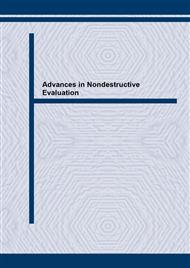[1]
S. Rahman: International Journal of Pressure Vessels and Piping, Vol. 70 (1997), pp.223-236.
Google Scholar
[2]
H. Machida and S. Yoshimura: International Journal of Pressure Vessels and Piping, Vol. 79 (2002), pp.193-202.
Google Scholar
[3]
R. Rastogi, V. Bhasin, K.K. Vaze and H.S. Kushwaha: Nuclear Engineering and Design, Vol. 212 (2002), pp.109-114.
Google Scholar
[4]
J.R. Rice: Journal of Applied Mechanics, Vol. 35 (1968), pp.379-386.
Google Scholar
[5]
V. Kumar, M.D. German and C.F. Shih: An Engineering Approach for Elastic-Plastic Fracture Analysis. EPRI Final Report NP-1931 (1981).
Google Scholar
[6]
A.M. Hasofer and N.C. Lind: Journal of Engineering Mechanics, Vol. 100 (1974), pp.111-121.
Google Scholar
[7]
R. Rackwitz and B. Fiessler: Computers and Structures, Vol. 9 (1978), pp.489-494.
Google Scholar
[8]
V. Kumar and M.D. German: Elastic-Plastic Fracture Analysis of Through-Wall and Surface Flaws in Cylinders. EPRI Report NP-5596 (1988).
Google Scholar
[9]
British Energy: R6-Assessment of the Integrity of Structures Containing Defects. Revision 4 (2001).
Google Scholar
[10]
Y.J. Kim, N.S. Huh and Y.J. Kim: Fatigue & Fracture of Engineering Materials & Structures, Vol. 24 (2001), pp.243-254.
Google Scholar
[11]
S. Rahman and J.S. Kim: International Journal of Pressure Vessels and Piping, Vol. 78 (2001), pp.261-269.
Google Scholar
[12]
American Petroleum Institute: API Recommended Practice 579-Fitness-for-Service. First Ed. (2000).
Google Scholar
[13]
ABAQUS Version 6. 2-1. User's manual, Hibbitt, Karlsson & Sorensen, Inc (2001).
Google Scholar


